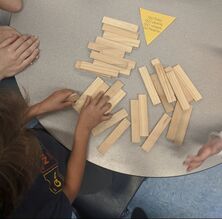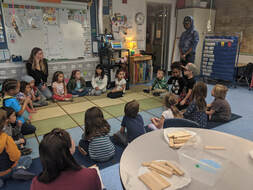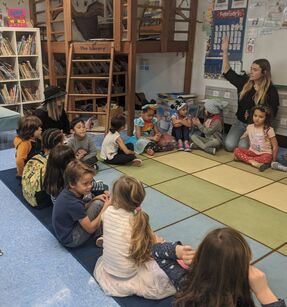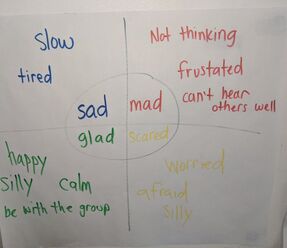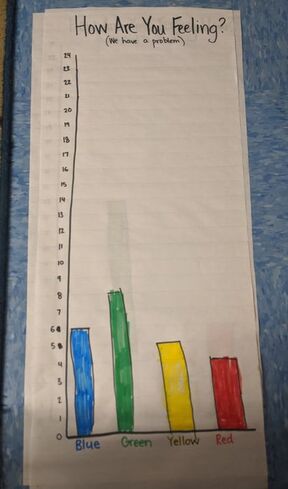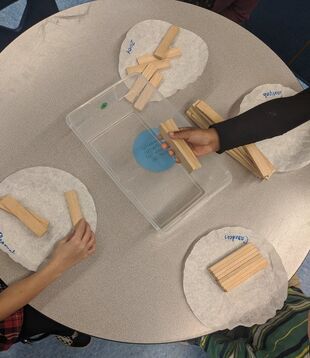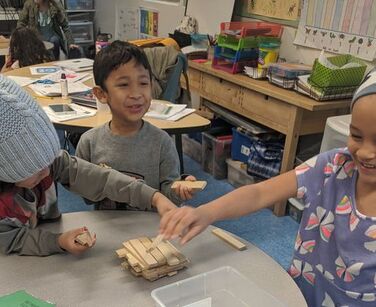Equal shares, fairness, and play
KINDERGARTNERS EXPERIENCE UNFAIRNESS THROUGH MATHEMATICS
Research Team
Addy Rigdon - Kindergarten teacher at High Tech Elementary Explorer; host teacher
Becca Maldonado - Science teacher at High Tech Elementary Explorer
Bailey Hawke - Third grade teacher at High Tech Elementary North County
Curtis Taylor - Equity commentator and 6th grade math/science teacher.
Becca Maldonado - Science teacher at High Tech Elementary Explorer
Bailey Hawke - Third grade teacher at High Tech Elementary North County
Curtis Taylor - Equity commentator and 6th grade math/science teacher.
Research Question & Theory of Action
lesson goals
|
Content Understanding Goals:
Kindergartners will compare the number of objects in a group to identify unequal shares. |
Equity Goal:
Kindergartners will recognize, grapple with, and generate solutions for unfairness when presented with unequal distribution of resources. |
Social Emotional Goal:
Students will self-identify their emotional state, and begin to independently problem solve and self-regulate. |
background research
Click the links below to check out the body of research that informed our lesson design!
Focus Students
As a group, we chose three different students that we predicted would bring different strengths and face different challenges while grappling with the lesson goals. The team worked to anticipate the thinking of these three students, and incorporated scaffolds that would help these students reach the content understanding, social emotional and equity goals. These students will be referred to as FS1, FS2 and FS3.
|
Focus Student 1
FS1 is an enthusiastic learner who shares her opinions and emotions freely. She can have quite large reactions when she feels upset. She is a keen observer in the classroom, and will likely notice unequal shares right away. Mathematically, we hope to see her start to distribute materials to make equal shares. We also hope to see her grapple with fair distribution and express her opinion about inequality in a constructive way. |
Focus Student 2
FS2 is an energetic student who loves to move and play. He is very kind and open to sharing with friends during group play. Our goal is that he will stay engaged in the lesson throughout the launch, grapple, problem solving, and second grapple. Another goal for FS2 is to share his opinions about grouping. |
Focus Student 3
FS3 is a curious student who is excited about mathematics. We think that he will already be able to make equal shares. Our hope for him is to accurately create numerically equivalent groups, rather than just notice unequal shares. Academically, he is achieving at an end of kindergarten level. He is still working on collaboration and sending messages in a kind way. We would like to see him collaborate to create fair distribution despite having a resource advantage. |
research lesson OVERVIEW
Kindergarten students explored fairness and grouping through a small group (table groups of 4) math activity. The lesson launched with a book to spark student thinking about building. Immediately afterward, students were given a limited and unequal number of blocks to play with. Students noticed the unequal shares right away and reacted in different ways. Once the problem was realized, students paused their activity to participate in a problem-solving circle on the carpet.
During the circle, students self-identified their own emotional state using the zones of regulation. The class made a bar graph of how they were feeling. They then went on to brainstorm ways to solve the problem of unequal shares. Students generated several different solutions, from building one structure collaboratively to dividing blocks equally. They went off to their small groups to try out their solution and divide manipulatives into equal shares after finishing up the problem solving circle. They negotiated with one another to group their blocks in a way that felt equal or fair. Some students chose to distribute blocks equally amongst the 4 individuals at the table, others divided blocks in half and built with a partner, and two groups chose to build one creation all together.
After grappling to distribute resources and regulate their emotional state, students were given open play time with the blocks. To close the lesson, students self-identified which zone they were in again and shared how they were feeling. They noticed that they felt better overall after trying to problem solve and once things felt more fair at their tables.
Check out our lesson plan, attached below, for more information about the structure of this lesson.
Check out our lesson plan, attached below, for more information about the structure of this lesson.
student work and OBSERVATIONS

Bailey's Notes on FS1: Bailey observed her student becoming very frustrated with the amount of blocks she was given. Without looking about at other students' block FS1 was immediately frustrated with her six blocks and refused to build. She counted them up, pushed them away, and crossed her arms. After Ms. Addy problem solved with the students, FS1 seemed willing (at the carpet) to get back to building and come up with a share to share her blocks with her table. FS1 had a difficult time compromising on a plan and began counting each persons blocks over and over again. She watched others build and counted blocks, but didn’t build with her own blocks. She was unhappy with the outcome: cried, refused to compromise or build. She needed to be comforted and work one on one with Ms. Addy after the lesson.
Bailey's Notes on FS1: Bailey observed her student becoming very frustrated with the amount of blocks she was given. Without looking about at other students' block FS1 was immediately frustrated with her six blocks and refused to build. She counted them up, pushed them away, and crossed her arms. After Ms. Addy problem solved with the students, FS1 seemed willing (at the carpet) to get back to building and come up with a share to share her blocks with her table. FS1 had a difficult time compromising on a plan and began counting each persons blocks over and over again. She watched others build and counted blocks, but didn’t build with her own blocks. She was unhappy with the outcome: cried, refused to compromise or build. She needed to be comforted and work one on one with Ms. Addy after the lesson.

Focus Student 2: FS2 was absent on the day of the lesson.

Becca's Notes on FS3: FS3 walked around the entire classroom looking at every set of blocks before settling down at his desk. FS3 went to his seat quietly and began to build independently. During the problem solving meeting FS3 did not raise his hand to share. He had a hard time sharing blocks because he started out with more than others at his table. Back at the tables, he suggested sharing with FS1 and then took her blocks. The two built together briefly, and compared their structure against their other 2 table mates. They checked over and over to see if they had distributed fairly. They tried to convince each other about how to distribute evenly and ended up counting them out. FS1 and FS2 counted the blocks several times (both accurately and inaccurately, independently and with the help of Ms. Addy). At the end of the lesson FS2 voted for being in the red zone emotionally.
Curtis's Notes on Equity: Curtis shared the importance of a loving environment in a culturally responsive classroom and how apparent that was in Addy's classroom. During the building time Curtis noticed a diverse group of students being called on and sharing. Curtis noticed how Addy pushed the cognitive load onto students during various points throughout the lesson. She asked questions like "How can we check if this is fair?" Curtis noticed that FS3 was really grappling with this lesson- he was trying to figure out the sharing and fairness. He and many other experienced productive struggle. One idea Curtis shared is that he would have loved to hear a question about unfairness connections beyond school from the students. Curtis believed this specific question would have allowed them to take in what they experienced in the lesson, and push their thinking to a historical & real world context.
REFLECTION
|
Reflections from FS1 and another student:
|
Teacher reflection on the lesson:
|
|
|
|
Key takeaways and next steps
Addy - Students are able to grapple with difficult content independently when given the chance. I was really impressed by how quickly and respectfully students were able to identify unfairness and share about how it made them feel. For some students, emotional reactions can get in the way of student learning which makes Addy want to do more reteaching on social emotional learning like size of the problem vs. size of the reaction and self soothing strategies. She is also eager to design lessons that build off of this one and bring in real world examples of unfairness and inequality.
Bailey - After the lesson, Bailey was impressed how play could lead to discussion about equity. One thing that Bailey is taking away from this lesson is that she wants to give her students opportunities to grapple with unfairness and unequal shares of objects. While carefully planning a debrief from the lesson, Bailey wants her students to explore unfairness and unequal shares in her students' lives and personal experiences.
Becca - Becca thinks we need to help students, families, and ourselves celebrate the hard work, the partial successes, and the growth that comes with experiencing that discomfort. The brain is growing when make mistakes and we should help people see their growth from the climb.
Bailey - After the lesson, Bailey was impressed how play could lead to discussion about equity. One thing that Bailey is taking away from this lesson is that she wants to give her students opportunities to grapple with unfairness and unequal shares of objects. While carefully planning a debrief from the lesson, Bailey wants her students to explore unfairness and unequal shares in her students' lives and personal experiences.
Becca - Becca thinks we need to help students, families, and ourselves celebrate the hard work, the partial successes, and the growth that comes with experiencing that discomfort. The brain is growing when make mistakes and we should help people see their growth from the climb.
